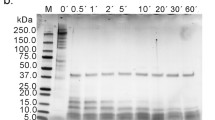Abstract
We recently reported that the rat mast cell proteinase inhibitor trypstatin is genetically identical with the second half of inter-α-trypsin inhibitor light chain (ITI-LC), also known as bikunin or urinary trypsin inhibitor (UTI). In this study, therefore, immunoreactivities of mast cells of various human tissues were examined with three antibodies, anti-human ITI-LC, anti-ITI, which recognizes mainly heavy chains or the sugar moiety of ITI, and anti-α 1-microglobulin (α1mG). ITI-LC immunoreactivity was strongly found in mast cells in the connective tissues of various organs except for those of the propria mucosae of small intestine. Neither anti-ITI antibody nor anti-α1mG antibody reacted with mast cells in various tissues. By reverse transcription-polymerase chain reaction (RT-PCR) analysis, α1mG/ITI-LC mRNA was not detected in the skin and tongue, and only weakly in small intestine, although ITI-LC immunoreactivity was strongly detected in these tissues. Furthermore, the mRNA was not expressed in cultured human mast cells. These results suggest that ITI-LC protein is stored in the granules of human connective tissue mast cells, though is not produced by them.
Similar content being viewed by others
Author information
Authors and Affiliations
Additional information
Received: 14 September 1998 / Accepted: 15 February 1999
Rights and permissions
About this article
Cite this article
Ide, H., Itoh, H., Yoshida, E. et al. Immunohistochemical demonstration of inter-α-trypsin inhibitor light chain (bikunin) in human mast cells. Cell Tissue Res 297, 149–154 (1999). https://doi.org/10.1007/s004410051342
Issue Date:
DOI: https://doi.org/10.1007/s004410051342




